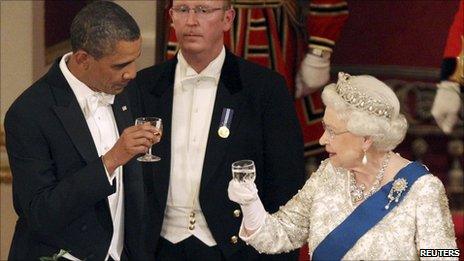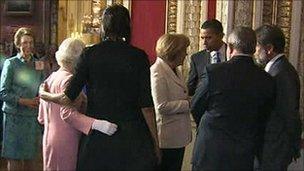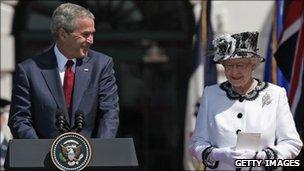Why are there rules for meeting the Queen?
- Published

President Barack Obama raised eyebrows when he continued speaking during the national anthem with commentators suggesting protocol had been breached. But what is royal protocol and is it necessary?
Barack Obama was probably not aware that he was doing anything unusual when making a toast "to the Queen" and then continuing with a short speech, external. According to protocol, however, he should have stopped after the toast.
The band, taking its cue from the word Queen, struck up with the national anthem leaving the president struggling to make himself heard.
What happens when the Queen is toasted is all part of protocol, an elaborate set of customs and rules that govern interactions with the British royal family.
Some fuss was also made during a previous visit by the Obamas, when Michelle put her arm around the Queen, another protocol breach.
Mrs Obama's action echoed similar slip-ups by Australian prime ministers. In 2000, John Howard appeared to have put his arm around the Queen, but that was as nothing compared to the furore caused by Paul Keating when he put his arm around the Queen during her 1992 tour of Australia, and was dubbed "the Lizard of Oz".

Michelle Obama took the unusual step of hugging the Queen during the First Lady's previous UK visit
When meeting a royal, there are rules about who can speak first, where to look, what to call them, how you should stand and when you should sit. It is a mysterious business to the uninitiated.
But it stems from a time when monarchs were accorded an almost divine status and had to be treated accordingly.
"From medieval times, monarchs were divinely appointed to rule by God, so they were kind of seen as gods, so they demanded to be treated as gods," says Dr Kate Williams, a historian at London's Royal Holloway university.
"They are treated as people set apart from the rest of us, so primarily what it is creating is distance and grandeur."
In short, says Dr Williams, "you don't kiss them, you don't touch them, you bow - over and over again."
But in an era when a woman with ancestors who worked in the coal mines can become a princess, does royal etiquette really matter?
The reaction to Mrs Obama touching the Queen in 2009 would suggest it does to some people.
"Meeting the Queen may never be the same again after an extraordinary show of affection with Michelle Obama," wrote Andrew Pierce in the Daily Telegraph in 2009.
For David Miller, director of Debrett's, royal etiquette is a helpful set of instructions to show people how to behave in an unfamiliar social setting.
"It's a code of conduct in terms of the way in which people behave at occasions and eventualities that they do not encounter on an everyday basis," he says.
"Yes, it's wrapped up in history and tradition, but it's also practical, universal and there to avoid embarrassment."
Royal protocol can be viewed as an expression of respect for the Queen.
William Hanson, a protocol expert who trained staff for the luxury liner Queen Mary II, says the Queen, with all she has been through, her unique perspective and position in the nation's history, deserves the respect she is afforded.
"It's because we respect her and what she stands for - she stands for all that is great in British society," he says.
But there is evidence that things are becoming more relaxed.

George Bush was reported to have received advice on protocol when the Queen visited the US
Jennie Bond spent 14 years negotiating royal protocol as a part of her job as royal correspondent for the BBC.
"I don't think that they are as hot on etiquette as most people think they are," she says.
"They like people to curtsy, but you're always told at royal briefings that it's up to you. As a journalist, I never did.
"All this thing about not speaking to the Queen unless you're spoken to, I don't believe that, I always used to tell her jokes."
Dr Williams says royal etiquette has adapted to reflect the shift in what we expect from our royal family.
"I think it is changing, I think in the earlier period people wanted their monarch to be set apart from them, that's what they wanted, they wanted someone more powerful [to protect them]," she says.
"We're less and less engaged with the idea of a monarch being distant. For example, Princess Diana gained popularity because she was so much less formal."
But Mr Hanson believes etiquette still has a role to play, beyond royal circles as much as within them.
"These things matter, especially when you're doing business with eastern countries such as China, where they take it even more seriously than Britain," he says.
"The Japanese, the Chinese, the Middle Eastern countries, are more concerned with protocol day-to-day."
Mr Hanson sees a deeper importance behind the principles of etiquette.
"If you get the little things right, all the other things fall into place. It's about respect and deference in society, and that is what we're lacking."
As for the recent faux pas by Mr Obama, Mr Hanson says: "It's not going to spell the end of cordial relations between America and Britain, but it's always nice to get these things right."